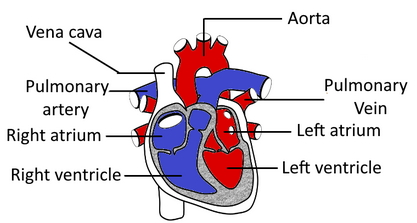
Arteries carry oxygenated blood, except
(a)Coronary artery
(b)Hepatic artery
(c)Aorta
(d)Pulmonary artery
Answer
486.9k+ views
Hint: This is the only artery that carries blood with relatively low oxygen and high carbon dioxide content into the lungs. It is further divided into two branches that send blood to the respective side of lungs.
Complete answer:
Pulmonary artery is a blood vessel that carries deoxygenated blood. It takes blood away from the human heart to all parts of the body like tissues, lungs, brain and other parts of the body. The pulmonary arteries are relatively short and wide. It is present at the exit of the right ventricle. It is divided into two parts left and right pulmonary arteries.
The arteries are a part of the cardiovascular system, which is liable for the delivery of oxygen and nutrients to all or any cells, also because of the removal of carbon dioxide and waste products, the upkeep of optimum blood pH, and the circulation of proteins and cells of the human system .
Additional Information:
-The pulmonary circuit starts from the pulmonary trunk, which is a large vessel that ascends diagonally from the right ventricle.
-Coronary arteries also aid the heart in pumping blood by sending oxygenated blood to the heart, allowing the muscles to function.
-The hepatic artery is a short blood vessel that supplies oxygenated blood to the liver, pylorus of the stomach, duodenum, pancreas, and gallbladder.
-The aorta is the important and largest artery in the human body, initiating from the left ventricle of the heart and extending down.
-Basically, veins take deoxygenated blood to the heart but the pulmonary veins carry oxygenated blood as well.
So, the correct answer is ‘Pulmonary artery‘.

Note: -The unique artery aside from the pulmonary artery is that of the umbilical artery, which carries deoxygenated blood from a fetus to its mother.
-The tissues of pulmonary arteries are less elastic and have thin distensible walls than the systemic arteries.
Complete answer:
Pulmonary artery is a blood vessel that carries deoxygenated blood. It takes blood away from the human heart to all parts of the body like tissues, lungs, brain and other parts of the body. The pulmonary arteries are relatively short and wide. It is present at the exit of the right ventricle. It is divided into two parts left and right pulmonary arteries.
The arteries are a part of the cardiovascular system, which is liable for the delivery of oxygen and nutrients to all or any cells, also because of the removal of carbon dioxide and waste products, the upkeep of optimum blood pH, and the circulation of proteins and cells of the human system .
Additional Information:
-The pulmonary circuit starts from the pulmonary trunk, which is a large vessel that ascends diagonally from the right ventricle.
-Coronary arteries also aid the heart in pumping blood by sending oxygenated blood to the heart, allowing the muscles to function.
-The hepatic artery is a short blood vessel that supplies oxygenated blood to the liver, pylorus of the stomach, duodenum, pancreas, and gallbladder.
-The aorta is the important and largest artery in the human body, initiating from the left ventricle of the heart and extending down.
-Basically, veins take deoxygenated blood to the heart but the pulmonary veins carry oxygenated blood as well.
So, the correct answer is ‘Pulmonary artery‘.

Note: -The unique artery aside from the pulmonary artery is that of the umbilical artery, which carries deoxygenated blood from a fetus to its mother.
-The tissues of pulmonary arteries are less elastic and have thin distensible walls than the systemic arteries.
Recently Updated Pages
The correct geometry and hybridization for XeF4 are class 11 chemistry CBSE

Water softening by Clarks process uses ACalcium bicarbonate class 11 chemistry CBSE

With reference to graphite and diamond which of the class 11 chemistry CBSE

A certain household has consumed 250 units of energy class 11 physics CBSE

The lightest metal known is A beryllium B lithium C class 11 chemistry CBSE

What is the formula mass of the iodine molecule class 11 chemistry CBSE

Trending doubts
Why was the Vernacular Press Act passed by British class 11 social science CBSE

Arrange Water ethanol and phenol in increasing order class 11 chemistry CBSE

Name the nuclear plant located in Uttar Pradesh class 11 social science CBSE

What steps did the French revolutionaries take to create class 11 social science CBSE

How did silk routes link the world Explain with three class 11 social science CBSE

What are the various challenges faced by political class 11 social science CBSE




